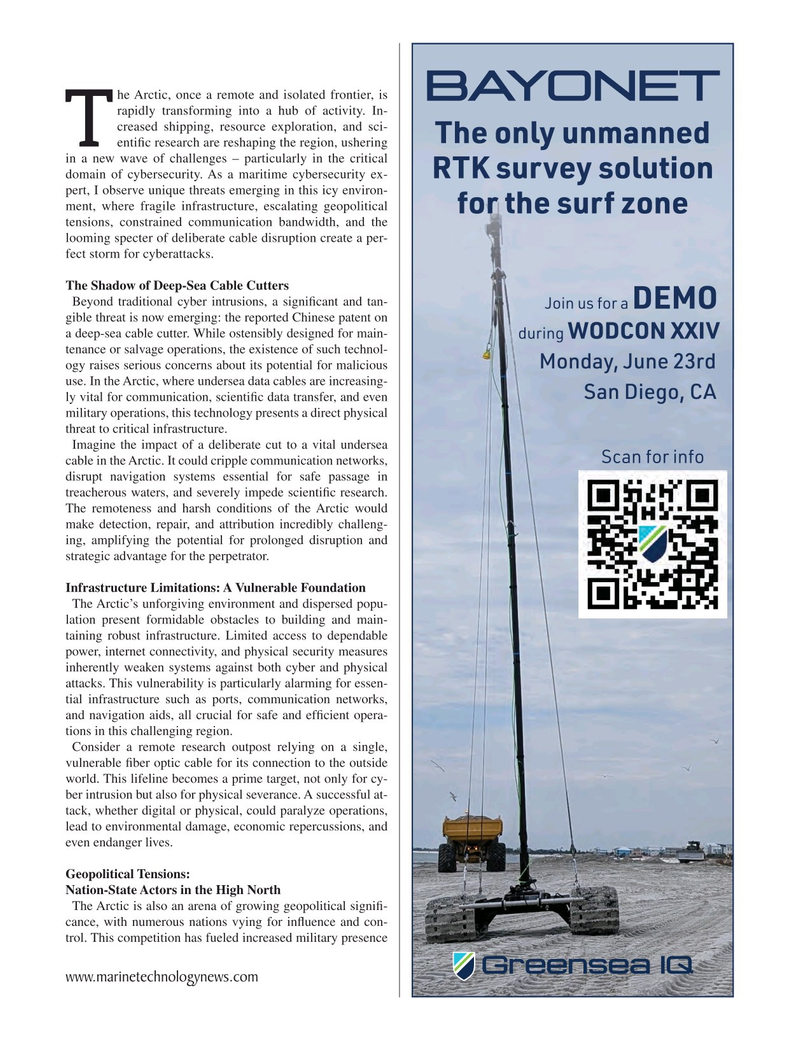
Page 13: of Marine Technology Magazine (May 2025)
Read this page in Pdf, Flash or Html5 edition of May 2025 Marine Technology Magazine
he Arctic, once a remote and isolated frontier, is
BAYONET rapidly transforming into a hub of activity. In- creased shipping, resource exploration, and sci-
The only unmanned
T enti? c research are reshaping the region, ushering in a new wave of challenges – particularly in the critical
RTK survey solution domain of cybersecurity. As a maritime cybersecurity ex- pert, I observe unique threats emerging in this icy environ- ment, where fragile infrastructure, escalating geopolitical for the surf zone tensions, constrained communication bandwidth, and the looming specter of deliberate cable disruption create a per- fect storm for cyberattacks.
The Shadow of Deep-Sea Cable Cutters
Beyond traditional cyber intrusions, a signi? cant and tan-
Join us for a DEMO gible threat is now emerging: the reported Chinese patent on a deep-sea cable cutter. While ostensibly designed for main- during WODCON XXIV tenance or salvage operations, the existence of such technol-
Monday, June 23rd ogy raises serious concerns about its potential for malicious use. In the Arctic, where undersea data cables are increasing-
San Diego, CA ly vital for communication, scienti? c data transfer, and even military operations, this technology presents a direct physical threat to critical infrastructure.
Imagine the impact of a deliberate cut to a vital undersea
Scan for info cable in the Arctic. It could cripple communication networks, disrupt navigation systems essential for safe passage in treacherous waters, and severely impede scienti? c research.
The remoteness and harsh conditions of the Arctic would make detection, repair, and attribution incredibly challeng- ing, amplifying the potential for prolonged disruption and strategic advantage for the perpetrator.
Infrastructure Limitations: A Vulnerable Foundation
The Arctic’s unforgiving environment and dispersed popu- lation present formidable obstacles to building and main- taining robust infrastructure. Limited access to dependable power, internet connectivity, and physical security measures inherently weaken systems against both cyber and physical attacks. This vulnerability is particularly alarming for essen- tial infrastructure such as ports, communication networks, and navigation aids, all crucial for safe and ef? cient opera- tions in this challenging region.
Consider a remote research outpost relying on a single, vulnerable ? ber optic cable for its connection to the outside world. This lifeline becomes a prime target, not only for cy- ber intrusion but also for physical severance. A successful at- tack, whether digital or physical, could paralyze operations, lead to environmental damage, economic repercussions, and even endanger lives.
Geopolitical Tensions:
Nation-State Actors in the High North
The Arctic is also an arena of growing geopolitical signi? - cance, with numerous nations vying for in? uence and con- trol. This competition has fueled increased military presence www.marinetechnologynews.com
MTR #4 (1-17).indd 13 MTR #4 (1-17).indd 13 5/27/2025 5:47:50 PM5/27/2025 5:47:50 PM

 12
12

 14
14
